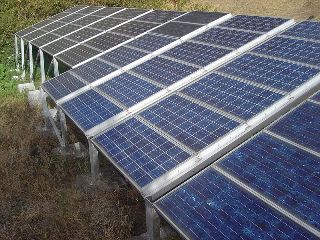Researchers from University of California, Riverside have discovered a novel method to enhance the efficiency of solar energy conversion by integrating inorganic semiconductor nanocrystals with organic molecules and “upconvert” photons in the visible and near-infrared regions of the solar spectrum.
 Chemists at the University of California, Riverside have found an ingenious way to make solar energy conversion more efficient. Photo Credit: David Monniaux.
Chemists at the University of California, Riverside have found an ingenious way to make solar energy conversion more efficient. Photo Credit: David Monniaux.
This innovative method could be the answer to reducing the overall costs of using solar cells. The cost of land to house solar cells and labor, tend to constitute the larger portion of the costs of using solar cells.
Solar cells are constructed with materials such as cadmium telluride or silicon which cost about 20% of the total cost.
To ensure that solar energy becomes inexpensive, the area of land required to house the solar panels must be reduced.
This can be best realized if every single solar cell could be made to produce more power.
The UC Riverside researchers published their research findings in Nano Letters
The infrared region of the solar spectrum passes right through the photovoltaic materials that make up today’s solar cells. This is energy lost, no matter how good your solar cell. The hybrid material we have come up with first captures two infrared photons that would normally pass right through a solar cell without being converted to electricity, then adds their energies together to make one higher energy photon. This upconverted photon is readily absorbed by photovoltaic cells, generating electricity from light that normally would be wasted.
Christopher Bardeen, a professor of chemistry
Furthermore Bardeen stated that these materials are fundamentally “reshaping the solar spectrum” thereby becoming ideal matches for the photovoltaic materials found in solar cells currently available in the market. It could be possible to enhance the efficiencies of solar photovoltaic cells by 30% or more by utilizing the solar spectrum’s infrared region.
Bardeen and Tang used lead selenide and cadmium selenide semiconductor nanocrystals for their project. They prepared the hybrids with organic compounds such as rubrene and diphenylanthracene. The cadmium selenide nanocrystals were able to convert visible wavelengths to UV photons. However, the lead selenide nanocrystals were capable of converting near-infrared photons to visible photons.
In the lab, the researchers aimed 980nm infrared light at the hybrid material, which subsequently generated upconverted orange/yellow fluorescent 550nm light. This doubled the energy of the incoming photons.
UC Riverside researchers coated the cadmium selenide nanocrystals with organic ligands which helped to improve the upconversion process by almost three orders of magnitude, thereby providing a means to reach better efficiencies.
This 550-nanometer light can be absorbed by any solar cell material. The key to this research is the hybrid composite material – combining inorganic semiconductor nanoparticles with organic compounds. Organic compounds cannot absorb in the infrared but are good at combining two lower energy photons to a higher energy photon. By using a hybrid material, the inorganic component absorbs two photons and passes their energy on to the organic component for combination. The organic compounds then produce one high-energy photon. Put simply, the inorganics in the composite material take light in; the organics get light out.
Bardeen
The concept of upconverting two low energy photons into one high energy photon can be applied in many other potential applications such as data storage, biological imaging and organic light-emitting diodes.
“The ability to move light energy from one wavelength to another, more useful region, for example, from red to blue, can impact any technology that involves photons as inputs or outputs,” he said.
The National Science Foundation and the U.S. Army provided grants to support this research.
The research was also assisted by the research paper coauthors - Zhiyuan Huang (first author), Xin Li, Melika Mahboub, Kerry M. Hanson, Valerie M. Nichols and Hoang Le.
Tang’s team designed the experiments and supplied the nanocrystals as well.
The UCR Office of Technology Commercialization has filed a provisional patent on the technology.
References